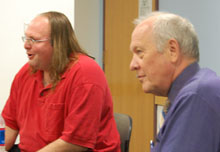Event
Zuckerman’s Media Cloud focused on thorough media analysis

October 6, 2009 — In his Shorenstein Center brown-bag talk, “Media Cloud and Quantitative Analysis,” Ethan Zuckerman, senior researcher at the Berkman Center for Internet and Society and co-founder of Media Cloud, explained how his new project attempts to track news coverage over time.
Media analysis in its current state is “really easy to do badly,” Zuckerman said, because information transferred through social media can be misleading. Zuckerman told the story of how people used Twitter to promote protests of a recent election in Moldova. A small group of people “re-tweeted” so extensively that the story circulated throughout the Internet, giving the appearance of a great uprising in the country. After inspection of all the media data, Zuckerman was able to trace the source back to the small band of “tweeters” and found the story to be different than its online presence suggested.
Rather than simply monitor Twitter to find the pulse of what’s going on in the world, Zuckerman’s project uses a complicated mapping system to enlarge the pool of data created by all forms of media. By subscribing to thousands of news sites and blogs, Media Cloud is able to trace patterns across a huge data set.
Zuckerman says that it is “critical that media consumers in a digital age have a way of monitoring news consumption,” and hopes Media Cloud will be able to provide a replicable tool to improve media tracking and research.
Some challenges the project faces is what Zuckerman calls “dark matter,” such as Facebook, email and information behind paywalls, that are not accessible to the Media Cloud search engine. They are also looking for ways to control access to their database.
Media Cloud is creating a “rough set of tools and big set of data” to better track how international and local news has changed over time, and to make linguistic analysis and research more accessible and accurate.
This article was written by Janell Sims and the photos taken by Leighton Walter Kille, both of the Shorenstein Center.